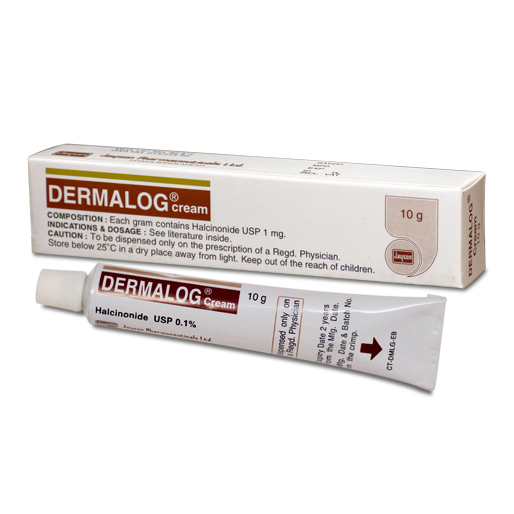Dermalog Uses, Dosage, Side Effects and more
The precise mechanism of action of topical corticosteroids is unclear. However they possess anti-inflammatory, antipruritic, and vasoconstrictive actions. New research indicates that halcinonide activates MBP (myelin basic protein) expression via smoothened receptor activation. This finding suggests that halcinonide could be used in the treatment of multiple sclerosis therapy as an alternative to Dexamethasone or Methylprednisolone.

| Attribute | Details |
|---|---|
| Trade Name | Dermalog |
| Generic | Halcinonide |
| Halcinonide Other Names | Halcinonid, Halcinonida, Halcinonide, Halcinonidum |
| Weight | 0.1% |
| Type | Cream |
| Formula | C24H32ClFO5 |
| Weight | Average: 454.96 Monoisotopic: 454.19223 |
| Groups | Approved, Investigational, Withdrawn |
| Therapeutic Class | Other Topical corticosteroids |
| Manufacturer | Jayson Pharma Ltd |
| Available Country | Bangladesh |
| Last Updated: | January 7, 2025 at 1:49 am |
Uses
Dermalog Cream is used for the relief of the inflammatory and pruritic manifestations of corticosteroid-responsive dermatoses.
Dermalog is also used to associated treatment for these conditions: Dermatosis, Corticosteroid-responsive dermatoses
How Dermalog works
The precise mechanism of action of topical corticosteroids is unclear. However they possess anti-inflammatory, antipruritic, and vasoconstrictive actions.
New research indicates that halcinonide activates MBP (myelin basic protein) expression via smoothened receptor activation. This finding suggests that halcinonide could be used in the treatment of multiple sclerosis therapy as an alternative to Dexamethasone or Methylprednisolone.
Dosage
Apply the 0.1% Dermalog Cream to the affected area two to three times daily. Rub in gently.
How Long Does It Take to Work?
How Long Does It Take to Work? see here Dermalog
Side Effects
Prolonged application causes epidermal thinning, contact dermatitis, perioral dermatitis, papular disorder, mild depigmentation; telangiectasia, striae (especially face and flexures). Application on eyelids and surrounding skin can raise intraocular pressure, cataracts, glaucoma, corneal ulcers and raised intracranial pressure. Systemic absorption with adrenal suppression may be seen when applied to large areas, when skin is broken or under occlusive dressing.
Toxicity
Systemic absorption of topical corticosteroids has produced reversible hypothalamicpituitary-adrenal (HPA) axis suppression, manifestations of Cushing’s syndrome, hyperglycemia, and glucosuria in some patients. Conditions which augment systemic absorption include the application of the more potent steroids, use over large surface areas, prolonged use, and the addition of occlusive dressings.
Precaution
Neonates, childn, elderly, hepatic failure. Not to be applied over large areas under occlusive dressings. Caution when applied to areas of broken skin. Pregnancy, lactation.
Food Interaction
No interactions found.Pregnancy & Breastfeeding use
Pregnancy Category C. Corticosteroids are generally teratogenic in laboratory animals when administered systemically at relatively low dosage levels. The more potent corticosteroids have been shown to be teratogenic after dermal application in laboratory animals. There are no adequate and well-controlled studies in pregnant women on teratogenic effects from topically applied corticosteroids. Therefore, topical corticosteroids should be used during pregnancy only if the potential benefit justifies the potential risk to the fetus. Drugs of this class should not be used extensively on pregnant patients, in large amounts, or for prolonged periods of time.
Nursing Mothers: It is not known whether topical administration of corticosteroids could result in sufficient systemic absorption to produce detectable quantities in breast milk. Systemically administered corticosteroids are secreted into breast milk in quantities not likely to have a deleterious effect on the infant. Nevertheless, caution should be exercised when topical corticosteroids are administered to a nursing woman.
Contraindication
Topical corticosteroids are contraindicated in those patients with a history of hypersensitivity to any of the components of the preparations, Primary infectious (viral, fungal, bacterial) ulcers, acne vulgaris.
Special Warning
Pediatric Use: Pediatric patients may demonstrate greater susceptibility to topical corticosteroid-induced HPA axis suppression and Cushing's syndrome than mature patients because of a larger skin surface area to body weight ratio.
HPA axis suppression, Cushing's syndrome, and intracranial hypertension have been reported in children receiving topical corticosteroids. Manifestations of adrenal suppression in children include linear growth retardation, delayed weight gain, low plasma cortisol levels, and absence of response to ACTH stimulation. Manifestations of intracranial hypertension include bulging fontanelles, headaches, and bilateral papilledema.
Administration of topical corticosteroids to children should be limited to the least amount compatible with an effective therapeutic regimen. Chronic corticosteroid therapy may interfere with the growth and development of children.
Geriatric Use: Of approximately 3000 patients included in clinical studies of 0.1% Dermalog cream , 14% were 60 years or older, while 4% were 70 years or older. No overall differences in safety were observed between these patients and younger patients. Efficacy data have not been evaluated for differences between elderly and younger patients. Other reported clinical experience has not identified differences in responses between the elderly and younger patients, but greater sensitivity of some older individuals cannot be ruled out.
Acute Overdose
Topically applied corticosteroids can be absorbed in sufficient amounts to produce systemic effects
Storage Condition
Should be stored in cool and dry place
Innovators Monograph
Dermalog contains Halcinonide see full prescribing information from innovator Monograph, MSDS, FDA label



